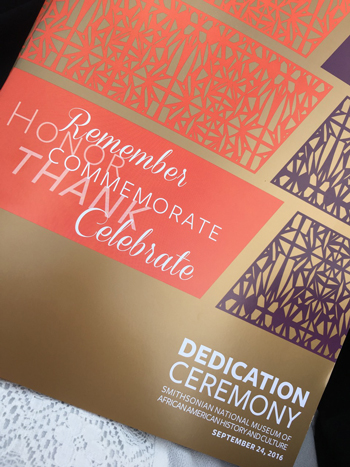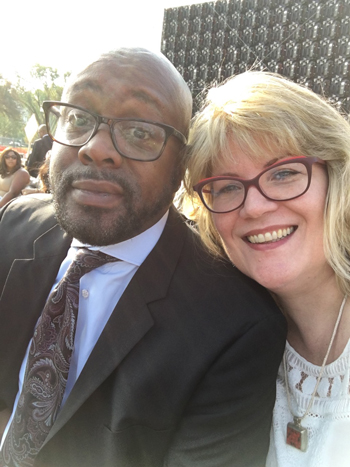In our second installment of the NMAAHC dedication series, we talked to the designer, educator, and owner of Anne Likes Red, Inc. Anne Kerns, her husband Billy Mayfield, and Shannon Washington, a graphic designer at a DC-based non-profit.
AIGA DC: Anne and Billy, what does the opening of the National Museum of African American History and Culture mean for you and your family?
Anne Kerns: Last year, my husband and I joined the museum as charter members, and we also bought two gift memberships for his family. As the opening approached, I became more and more excited about it, because of its significance, as well as the historic nature of the grand opening—100 years in the making—being dedicated by our first African American president.

(photo courtesy Anne Kerns)
I don’t think the majority of white Americans truly understand just how marginalized African Americans have been for so long. They don’t know the history of legal but unfair advantages they’ve had as white people, as well as the extent of the extrajudicial actions taken against black people. And I’m talking about after slavery was abolished. The NMAAHC tells some of that story. I’ve heard not even half of the collection is on display as there isn’t enough space for it all. Yes, it’s important to represent the ugly history because too many don’t know, but the museum also highlights amazing achievements of these Americans.
Billy Mayfield: For me, the opening of the museum was, needless to say, epic. I am very proud to be a black man. I also felt the loss of so many people that were in my life that were direct victims of racism and injustice.
AIGA DC: What were some of the most memorable moments for you?
Anne Kerns: I thought the dedication ceremony had a joyful atmosphere as well as a few somber moments. My favorite part was when Rev. Butts (from Abyssinian Baptist Church in Harlem) said, “Say it loud.” And I heard my beautiful husband proclaim, “I’m black and I’m proud,” with thousands of others. I loved all the speeches, and that so many important people were there, and people of many races. We should not try to pretend we don’t see each other; we should not be afraid to acknowledge what makes us different—we should celebrate it and honor it.
I hope that white folks will understand this is a museum for all, and visit it. Everyone can be enriched from the experience—I know I was.

(photo courtesy Anne Kerns)
Billy Mayfield: I was very glad to be present for that historic moment and to be there with my wife.
Shannon Washington: It was moving to be there—I felt like I was part of something big, proud to be part of the moment, to experience something that will be around for centuries to come. Being part of history. But also, thinking what can I do, what can I contribute to that history going forward?
. . .
Watch the dedication here, and be sure to read more posts in this series:
“A 100 Years in the Making, the National Museum of African American History and Culture Welcomes Thousands”
“Honor the Past by Being Present: the National Museum of African American History and Culture Opening Dedication”
(Lead photo courtesy of NMAAHC / Alan Karchmer)



